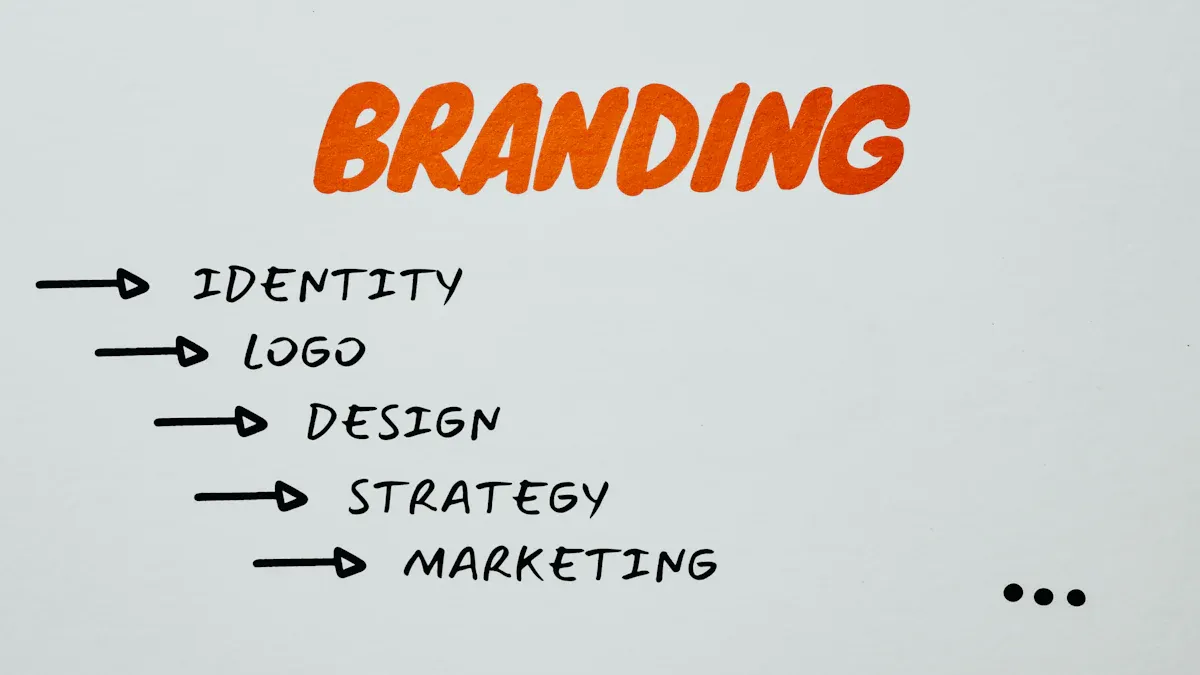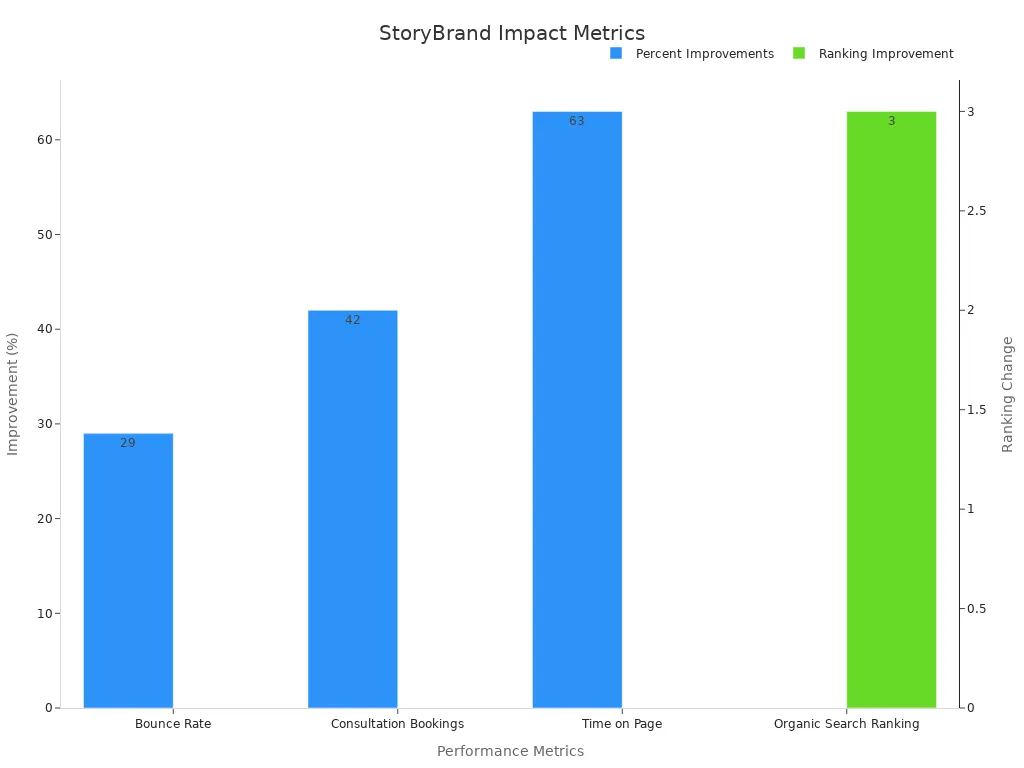
How to brand your business using storybranding
Table Of Contents

Storybranding is a framework for brand building that has gained popularity for good reason – it’s simple, it’s effective, and it applies to almost any company. A Storybrand helps you connect with customers by making them the hero on a heroes journey, and your business is the guide that helps them on the way.
In tech and biotech, you are not only building new tools—you are selling a future. A strong storybrand approach can make your marketing more effective and engaging by getting at the values you share with your target customers, and orienting your company as a companion that helps them change their lives.
Market research shows that branding with a compelling vision creates emotional connections, builds trust, and helps your business stand out. This bears itself out in design – Storybrand websites often see up to 300% more user engagement compared to traditional marketing, thanks to clear messaging and customer-focused storytelling. When you use storybranding, you give investors and customers a reason to believe in your business and its vision.
Storybranding makes your customer the hero and your business the helpful guide, creating strong emotional connections.
Use a clear, simple story that shows your customer’s problems and how your business helps solve them with a step-by-step plan.
Focus your message on your customer’s needs and dreams to build trust and keep them engaged.
Strong calls to action and clear success and failure outcomes help customers take action and see the value of your brand.
Storybranding improves brand awareness, customer loyalty, and sales by making your message easy to understand and memorable.
What Is Storybrand?

Storytelling in Branding
When you think about storybrand, you might think it’s about telling the story of your brand. But with a storybrand it’s not your company that is the hero, it’s the customer.
Today, brands do more than sell products—they share values, dreams, and even social missions with their customers. Storybrands position as a guide in helping customers achieve the life they want to live.
Recent research from Wharton shows that brand has changed. Now, it’s about being real, honest, and matching what your customer cares about, like sustainability or social responsibility. People are looking for trusted advisors that can mentor them forward.
Strong brand storytelling can make your product seem up to 20 times more valuable than just listing features.
Personal stories boost engagement by up to 300%.
Sharing your brand story builds trust and loyalty.
Brands like Apple and Nike use storybrand to inspire and connect with people, not just sell to them.
When you use storybrand, you invite your customer into your story. You show them why your business matters and how it fits into their lives.
Customer as Hero
Storybrand puts the customer front and center. You don’t just talk about your product—you show how it helps your customer become the hero of their own story. This approach works. For example, Nike’s “You Can’t Stop Us” campaign led to a 38% jump in online sales. LEGO grew revenue by 21% by making the customer front and center in their brand story. Dove’s “Real Beauty” campaign saw a 700% sales increase by focusing on real people and their stories.
Most people—92%—prefer ads that feel like stories. When you use storybrand, you help your customer see themselves as the main character. This builds a strong emotional bond and keeps them coming back.
Core Storybrand Principles
The Seven-Part Framework
The storybrand framework gives you a simple way to shape your brand’s message. It helps you tell a clear story that your customers can follow. This framework has seven parts, and each one plays a big role in making your brand stand out. Many startups and big brands use the storybrand framework to connect with people. Over one million copies of the book have sold, and companies like TREK, TOMS, and The Economist use it to grow. The storybrand framework makes your message easy to understand and remember. When you use it, you help your customers see themselves as the hero of their own journey.
Here’s what makes the storybrand framework so powerful:
It puts the customer at the center of the story.
It shows your brand as the guide, not the hero.
It helps you talk about the problem your customer faces.
It gives a clear plan for solving that problem.
It calls your customer to action.
It shows what success looks like.
It warns about what happens if they do nothing.
Many business leaders say the storybrand framework makes their message stronger and easier for customers to trust. When you use these steps, you make your brand’s story simple and exciting.
Guide and Plan
You want your customers to feel supported. The storybrand approach helps you do this by making your brand the guide. You show empathy and give a plan that leads your customer to success. Brands like Nike use emotional stories, like the ones about Michael Jordan, to build strong bonds with people. Spotify’s “Wrapped” campaign lets users see their own music story, making them feel special and understood.
Did you know? 68% of people say brand stories influence what they buy, and 92% like ads that feel like stories.
When you act as both guide and planner, you build trust. You help your customers see the path forward. Neuroscience shows that stories with positive emotions make people remember your brand and want to come back. By using the storybrand framework, you create a plan that feels real and hopeful. This makes your brand stand out and helps you build a loyal community.
How to Brand Your Business
Branding your business with storybrand means you create a clear, simple message that puts your customer at the center. You use a proven process to build a brandscript that guides your marketing and helps you stand out. Let’s walk through each step so you can see how to brand your business using storybranding.
Define the Customer
Start by figuring out who your customer is. In storybrand, the customer is always the hero of your brand story. You want to know what they care about, what they dream of, and what keeps them up at night. For tech and biotech startups, your customer might be a busy doctor, a curious investor, or a patient looking for hope.
Here’s a quick way to break down your customer:
Psychographic & Behavioral Factors | Segmentation Criteria | |
|---|---|---|
Age, gender, income, education, geographic location | Lifestyle, personality, values, interests, purchasing behavior, preferences, decision-making processes | Measurable, Accessible, Substantial, Actionable, Stable |
You want to focus on one main desire your customer has. Maybe they want to save time, feel safer, or make a difference. When you know this, you can shape your brandscript and marketing to speak directly to them.
Tip: Create a simple customer persona. Give them a name, a job, and a goal. This makes your storybrand marketing feel real and personal.
Identify the Problem
Every hero faces challenges. Your customer does, too. In storybrand, you need to name the problem your customer faces. This isn’t just about the obvious issues. Go deeper.
External problems: These are the clear, visible challenges. For example, a biotech customer might struggle to find reliable lab results.
Internal problems: These are the feelings behind the challenge. Maybe your customer feels frustrated, worried, or overwhelmed.
Philosophical problems: These are the big-picture questions. Is it fair that only some people get access to new treatments? Should technology be easier to use?
Many businesses miss the mark by only talking about external problems. Storybrand helps you dig into the emotional side. When you show you understand both the outside and inside challenges, your customer feels seen.
Customers often get confused by unclear messaging.
Ignoring pain points leads to lost interest.
Using too much jargon can push people away.
Be the Guide
You are not the hero. You are the guide. In storybrand, your business shows both empathy and authority. You help your customer win.
74% of B2B buyers research online before making decisions. They want a guide who gives them answers and confidence.
Show your customer you understand their challenges. Share stories of how you’ve helped others. Use simple language. For example, a tech startup might say, “We know managing data is hard. We’ve helped hundreds of teams make it easy.”
Note: If a customer has one bad experience, 33% will consider switching brands. Keep your guidance clear and helpful.
Create the Plan
Now, give your customer a plan. In storybrand marketing, a plan is a simple set of steps that shows how your business helps the customer solve their problem. This makes your brand story easy to follow.
Step 1: Show the first action. For a biotech startup, this could be “Schedule a free demo.”
Step 2: Explain what happens next. “We’ll walk you through our platform and answer your questions.”
Step 3: Describe the result. “You’ll get faster, more accurate results for your patients.”
Keep your plan short and clear. Use checklists or bullet points. This helps your customer feel confident and ready to act.
Authenticity matters. Share real experiences and values.
Use catchy phrases that stick in your customer’s mind.
Consistent messaging across all marketing builds trust.
Call to Action
Every storybrand needs a strong call to action. Tell your customer exactly what to do next. Make it easy and obvious.
Use buttons like “Book a Consultation” or “Start Your Free Trial.”
Personalize your calls to action based on what your customer needs.
Make your forms simple and your language clear.
Tracking how many people respond to your call to action helps you see what works. For example, if more people sign up for your newsletter after you change your button text, you know your storybrand marketing is working.
Pro tip: Segment your audience. Send different messages to investors, doctors, or patients. This boosts engagement and conversions.
Show Success and Failure
Paint a picture of what happens if your customer follows your plan—and what happens if they don’t. In storybrand, this makes your brand story powerful.
Success: Show the happy ending. “You’ll save hours every week.” “Your patients will get better care.” “You’ll feel confident in your decisions.”
Failure: Remind them of the risks. “Without this solution, you might waste time or miss out on new opportunities.”
This step helps your customer see the value of your solutions. It also makes your brandscript memorable.
When you use storybrand marketing, you give your customer a vision of a better future. You also show what they might miss if they don’t act.
Step-by-Step Guide to Building Your BrandScript
Here’s a simple checklist for how to brand your business using storybrand:
Identify your customer and what they want.
Define their external, internal, and philosophical problems.
Position your business as the empathetic and authoritative guide.
Create a clear, actionable plan.
Design direct and transitional calls to action.
Paint a picture of success. 7. Highlight the risks of failure.
Combine these into a brandscript.
Craft clear, simple messaging for all marketing.
Update your website and materials to match your brandscript.
Monitor customer response and adjust as needed.
When you follow these steps, you build a compelling brand story that connects, inspires, and grows your business. Storybrand marketing helps you clarify your message, reach your audience, and show the world why your solutions matter.
Storybrand Marketing

Storybrand marketing helps you turn your brandscript into real results. You use storybrand to shape your website, campaigns, and social media. This approach makes your messaging clear and helps you connect with your audience. Let’s see how you can use storybrand marketing to grow your business.
Website Messaging
Your website is often the first place people meet your brand. Storybrand marketing makes your messaging simple and direct. You want visitors to know what you offer and how it helps them. Storybrand websites use clear calls to action, easy navigation, and strong customer-focused messaging. For example, companies like WonderCow and Donald Miller’s site use storybrand to guide visitors with clean design and clear steps. When you focus on simplifying your brand message, you help people find what they need fast. Analytics show that storybrand marketing can boost organic traffic by 52% and increase page views by 58%. You also see longer visits and more conversions.
Tip: Use your brandscript to write your homepage headline. Make it about your customer’s success, not just your product.
Funnels and Campaigns
Storybrand marketing works in your email funnels and ad campaigns, too. You use your brandscript to guide every step. Start with a clear message about the problem you solve. Show your plan and invite people to act. AttriSight, an AI marketing tool, shows that storybrand marketing leads to higher conversion rates and lower bounce rates. Companies like Ford and Proctor & Gamble use storybrand to drive conversions and improve profits. When you keep your messaging focused, you help customers trust you and take action.
Use a simple three-step plan in your emails.
Place calls to action where people can see them.
Remind customers of the success they can achieve.
Social Media
Social media is perfect for storybrand marketing. You can share stories, customer wins, and your vision for the future. Storybrand marketing helps you build trust and boost engagement. Research shows that 92% of people want ads that feel like stories. When you use storybrand, your messaging sticks—people remember stories much more than facts. Instagram Stories and branded content help you connect with your audience and show your brand’s values. Storybrand marketing can increase brand recall, trust, and even sales.
Remember: Simplifying your brand message on social media helps people understand and share your story.
Storybrand marketing gives you a clear path. You use your brandscript to shape every message, campaign, and post. This makes your brand easy to trust and hard to forget.
Benefits
Clarity and Focus
When you use storybranding, your message becomes clear and focused. You help your customer understand what you offer and why it matters. Many businesses see big changes after switching to storybrand strategies:
Enhanced customer engagement
Improved lead generation
Higher conversion rates
Revenue growth
You can see these improvements in real numbers. Take a look at this table:
Performance Metric | Improvement Example |
|---|---|
Bounce Rate | Dropped 29% after StoryBrand homepage reframe |
Consultation Bookings | Increased by 42% within three months |
Time on Page | Increased by 63% |
Organic Search Ranking | Improved from page 4 to page 1 for key keywords |

You give your customer a simple path to follow. This makes it easier for them to take action and helps your business stand out.
Customer Connection
Storybranding helps you connect with your customer on a deeper level. You use stories that make your brand easy to remember and share. People remember stories much longer than facts. When you use a story format, your customer understands your mission and values right away.
Comparative Aspect | Storybranding Advantage | Supporting Evidence / Statistic |
|---|---|---|
Memorability | Creates lasting impressions through emotional, character-driven narratives | Stories are remembered longer than product facts |
Ease of Understanding | Uses familiar story structure (beginning, middle, end) to convey brand values and mission | Story format aligns with consumer cognitive patterns |
Trust Building | Builds emotional connections by aligning with core values, especially resonating with Millennials | 62% of Millennials more likely to buy if engaged via storytelling |
Brand Personality Expression | Reflects unique brand traits (fun, serious, innovative) to humanize the brand | Enhances emotional connection and differentiation |
Shareability | Strong stories spread easily on social media, amplified by visuals and videos | Increases organic reach and engagement |
Consumer Engagement | Storybranding integrates emotional appeal and values, leading to stronger bonds than fact-based branding | Qualitative examples from brands like Dove and Kamik illustrate loyalty and differentiation |
You build trust by showing your customer that you understand their needs. When your customer feels seen, they want to come back and share your story with others.
Tip: Use real customer stories in your marketing. This makes your brand feel human and relatable.
Vision for the Future
Storybranding does more than help you today. It sets you up for future growth. You create a vision that your customer can believe in. Research shows that storytelling shapes how people see your brand and its place in the world. Brands like Dove and Omnisend use storybranding to challenge old ideas and inspire change.
You guide your customer through a journey. You show them not just what you do, but why it matters for the future. This approach helps your business stay strong and ready for new opportunities.
When you share a clear vision, you invite your customer to join you on the path to growth.
You now know how storybranding can help your business grow. When you follow the steps—define your customer, solve their problem, guide them, and show a clear plan—you build trust and stand out. Many startups see big results:
A fintech startup grew user sign-ups by 35% in six months.
SaaS companies increased conversions by 50% and revenue by 120%.
Sector | Challenge | Storybrand Approach | Result |
|---|---|---|---|
Biotech | Scaling research | Clear vision and messaging | More funding, faster growth |
Tech Startup | Launch delays | Agile, story-driven communication |
Start building your BrandScript today. Share your vision and help your customers become heroes! 🚀
FAQ
What is a BrandScript?
A BrandScript is a simple outline of your brand story. You use it to organize your message. It helps you show your customer as the hero and your business as the guide.
How do I know if my storybrand is working?
You can track results like more website visits, higher engagement, or more sales. If people understand your message and take action, your storybrand works.
Can I use storybranding for social media posts?
Absolutely! Storybranding works great on social media. You can share short stories, customer wins, or your vision. People love stories, so your posts will stand out.
Do I need a professional writer to create a BrandScript?
You don’t need a pro. You can start with simple words and real stories. Focus on your customer’s journey. If you want extra polish, a writer can help later.
How often should I update my BrandScript?
Update your BrandScript when:
You launch a new product
Your audience changes
Your business grows
Check it every few months to keep your message fresh.







